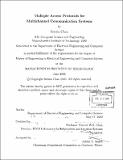Multiple access protocols for multichannel communication systems
Author(s)
Chan, Serena, 1977-
DownloadFull printable version (8.677Mb)
Other Contributors
Massachusetts Institute of Technology. Dept. of Electrical Engineering and Computer Science.
Advisor
Vincent W.S. Chan.
Terms of use
Metadata
Show full item recordAbstract
System architecture design, evaluation, and optimization are key issues to developing communication systems that meet the requirements of today and expectations of the future. In this thesis, we introduce the concept of multiple access communication and the need to use efficient transmission techniques to expand both present and future wireless communication networks. We will study two areas regarding multiple access on multichannel communication systems. First, we describe fundamental multiplexing techniques that we can build upon and investigate the performance of different candidate architectures for the transmission of messages from bursty sources on multiple channels. We will consider traditional protocols such as Time Division Multiple Access (TDMA) and Slotted ALOHA (S-ALOHA) alongside a channelized architecture, which is based on the idea of multiplexing by dividing total transmission capacity into a fixed number of frequency channels. We develop mathematical models that describe the overall delay for sending large messages of a fixed length arriving from bursty sources and analyze their performances. We will make real-world parameter assumptions in the context of wireless networks and analyze the performance to develop intuition about the effectiveness of the different architectures. Second, we will investigate channel capacity allocation among mixed traffic, i.e., multiple classes of users. We will consider a first-come first-serve (FCFS) access strategy, a non-preemptive priority scheme, a preemptive resume priority scheme, and several channel capacity allocation schemes. We develop models that describe the overall delay for sending messages and analyze their performance. Our focus will concentrate on two classes of users. This scenario is typical of classes of users with small and large messages to transmit. present quantitative results by making real-world parameter assumptions in the context of wireless networks and analyze the performance to develop intuition about the effectiveness of each architecture.
Description
Thesis (M.Eng.)--Massachusetts Institute of Technology, Dept. of Electrical Engineering and Computer Science, 2000. Includes bibliographical references (leaves 108-111).
Date issued
2000Department
Massachusetts Institute of Technology. Department of Electrical Engineering and Computer SciencePublisher
Massachusetts Institute of Technology
Keywords
Electrical Engineering and Computer Science.